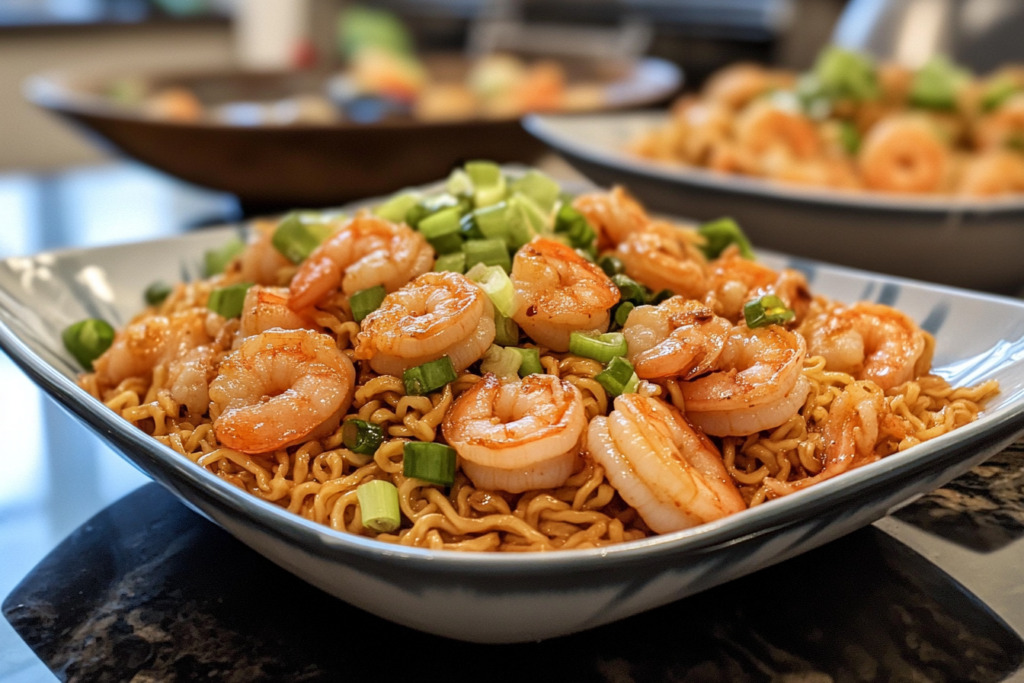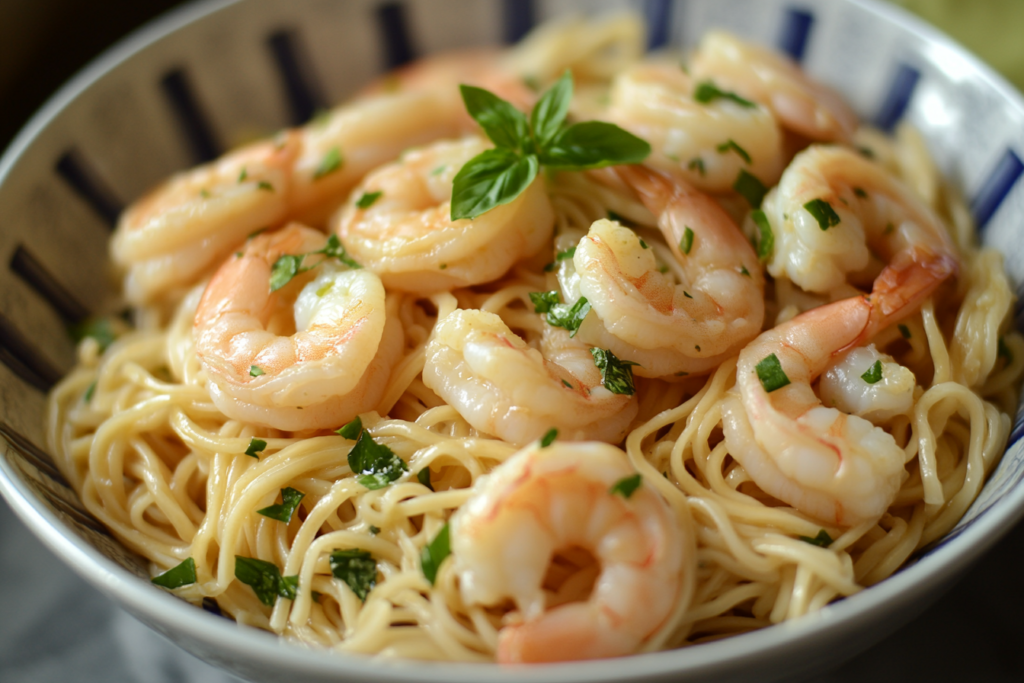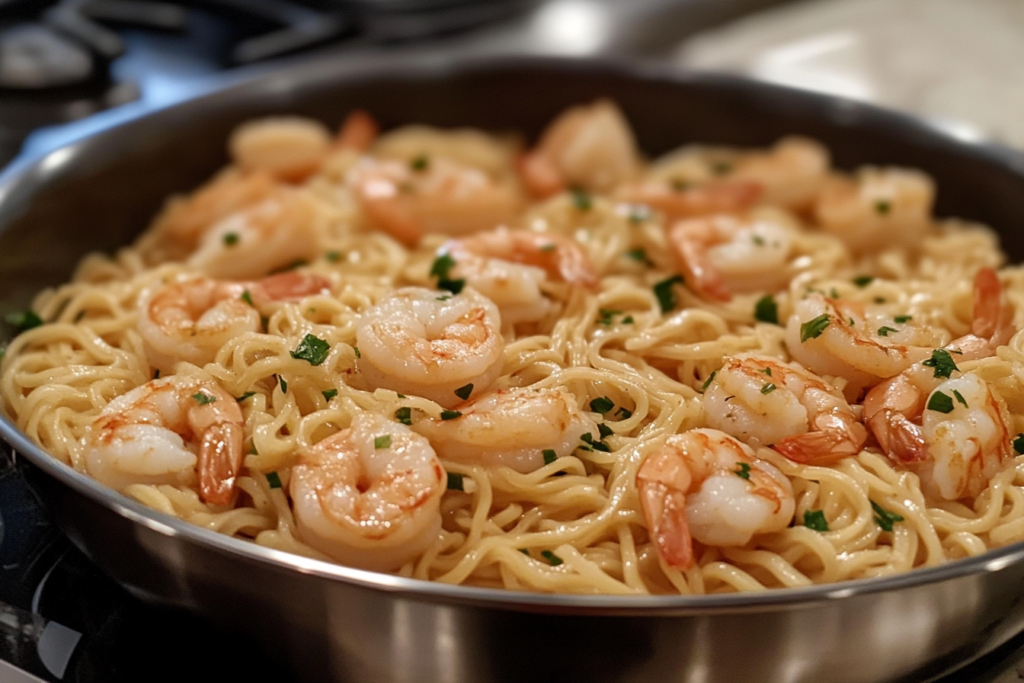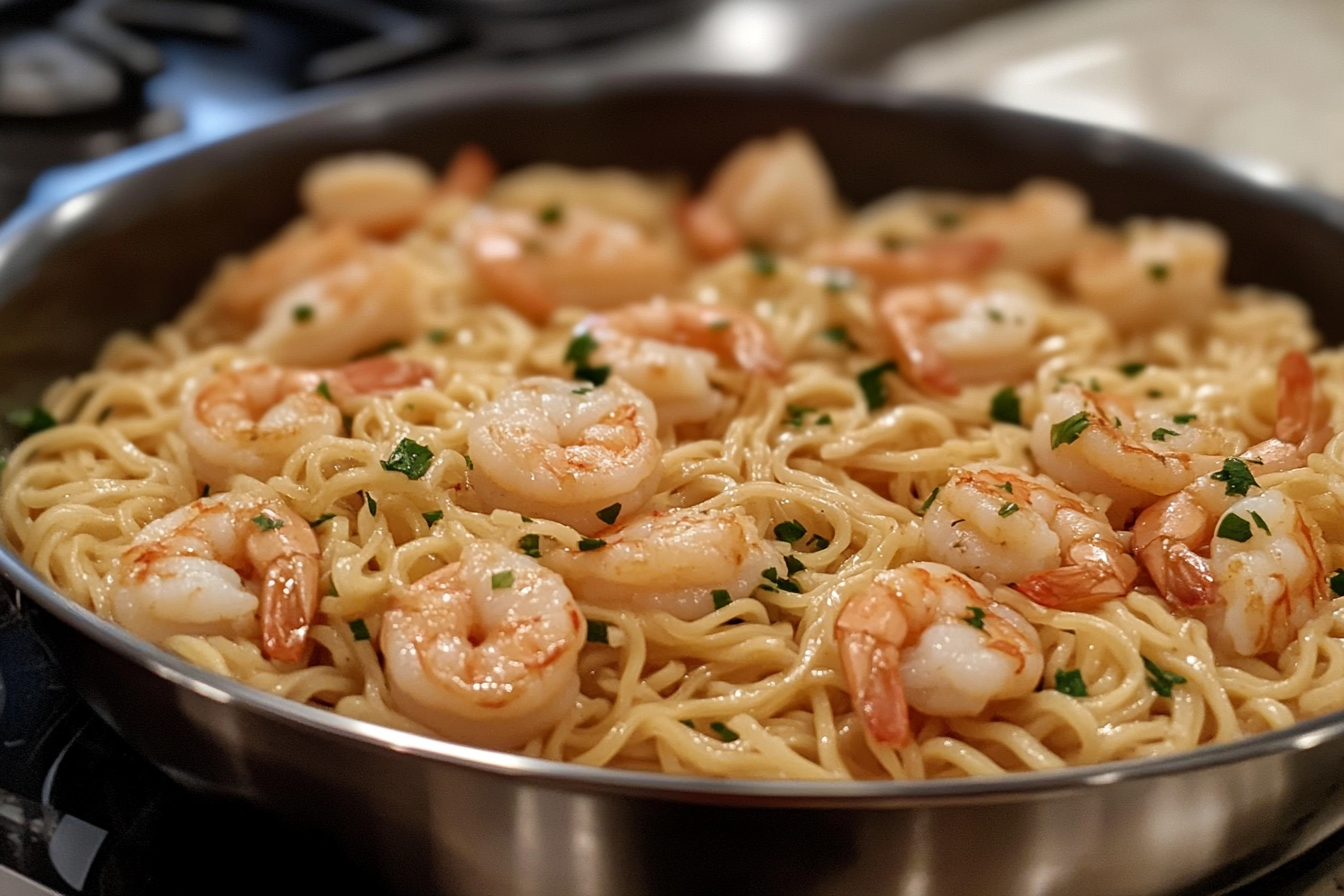Introduction to Shrimp Ramen and Its Components

What Is Ramen?
Shrimp Ramen Noodle Recipes , a dish steeped in Japanese culinary tradition, is far more than just a bowl of noodles. It features wheat-based noodles swimming in a flavorful broth, paired with a variety of toppings that add texture, taste, and vibrancy. This beloved meal has transcended borders, adapting to different palates and local ingredients around the world.
While classic ramen often includes pork or chicken, the use of shrimp introduces a fresh and delicate touch. Ramen isn’t just food; it’s an experience, a harmony of textures and flavors that tell a story of comfort and creativity.
Why Shrimp Is Perfect for Ramen
Shrimp isn’t just a protein option; it’s a flavor enhancer. Its natural sweetness and firm texture provide a lovely contrast to the savory broth and tender noodles. Shrimp also cooks quickly, making it a convenient choice for busy home cooks. Whether grilled, sautéed, or boiled, it infuses the broth with a seafood richness that’s both subtle and captivating.
Essential Ingredients for Shrimp Ramen Noodle Recipes
Creating an unforgettable shrimp ramen dish begins with selecting high-quality ingredients that work together seamlessly. Here’s what you’ll need:
- Noodles: Traditional ramen noodles are chewy and elastic, ideal for soaking up the broth’s essence. However, gluten-free or low-carb noodles are excellent alternatives.
- Broth: The soul of the dish! Common bases include chicken stock, vegetable broth, or seafood stock, often enriched with soy sauce, miso paste, or chili oil for added depth.
- Shrimp: Fresh, deveined shrimp works best. If frozen is all you have, ensure it’s properly thawed.
- Vegetables: Popular choices like bok choy, mushrooms, and scallions bring crunch and color to your bowl.
- Aromatics and Seasonings: Garlic, ginger, soy sauce, sesame oil, and chili paste create a symphony of flavors that elevate every bite.
Understanding Ramen and Its Components
What Is Ramen?
Ramen is much more than just a quick meal; it’s an intricate blend of history, culture, and culinary artistry. This Japanese noodle soup has its roots in Chinese cuisine but has evolved into a dish that embodies Japan’s rich culinary heritage. Featuring wheat-based noodles, it is typically served in a steaming bowl of meat or fish-based broth, offering layers of umami flavors. Common flavorings like soy sauce or miso add depth, while toppings such as nori (seaweed), scallions, and menma (fermented bamboo shoots) enhance the overall texture and taste.
Although ramen has numerous regional varieties, its appeal lies in its adaptability. From traditional recipes to modern interpretations, ramen caters to an endless array of preferences and dietary needs. Each bowl is a masterpiece, reflecting the creativity and skill of its maker.
The Role of Shrimp in Ramen Dishes
Shrimp plays a starring role in ramen, offering a unique twist to this timeless dish. Its natural sweetness balances the savory broth, while its firm yet tender texture contrasts beautifully with the noodles. Shrimp absorbs the surrounding flavors, enhancing the complexity of every bite.
Moreover, shrimp’s versatility makes it an ideal addition. Whether lightly sautéed, grilled, or poached, it seamlessly integrates into the ramen experience. Beyond flavor, shrimp adds visual appeal with its vibrant color, making the dish as beautiful as it is delicious. It’s no wonder shrimp ramen noodle recipes have become a favorite worldwide, loved for their simplicity and elegance.
Essential Ingredients for Shrimp Ramen
Crafting the perfect shrimp ramen noodle dish starts with high-quality ingredients that complement each other. Here’s a closer look at the essentials:
- Noodles: Traditional wheat ramen noodles are chewy and designed to hold the broth. However, rice noodles or low-carb alternatives are excellent substitutes for dietary preferences.
- Broth: The foundation of any ramen, the broth can range from light and clear to rich and creamy. Miso, soy sauce, or seafood-based broths add complexity and depth.
- Shrimp: Opt for fresh shrimp whenever possible, but frozen varieties work just as well. Ensure they are deveined and peeled for convenience.
- Vegetables: Bok choy, shiitake mushrooms, and scallions are classic choices that bring crunch and flavor. Experiment with spinach or corn for variation.
- Aromatics and Seasonings: Garlic, ginger, soy sauce, sesame oil, and chili paste are indispensable for a flavorful base. Don’t forget a dash of lime juice for a zesty finish.
By understanding these ingredients and their roles, you’ll have the building blocks needed to explore a variety of recipes and techniques.
Classic Shrimp Ramen Recipes

Traditional Shrimp Ramen
Authentic shrimp ramen noodle recipes begin with a robust broth that’s layered with umami flavors, perfectly cooked noodles, and tender shrimp. Here’s how to recreate this classic dish at home:
- Prepare the Broth:
- Heat sesame oil in a large pot over medium heat. Sauté minced garlic and ginger until fragrant.
- Add chicken or seafood stock (about 4 cups) and bring it to a simmer. Mix in soy sauce, mirin, and a hint of miso paste for depth. Let it simmer for 10 minutes.
- Cook the Shrimp:
- In a skillet, cook the peeled and deveined shrimp with a sprinkle of salt and pepper until pink and firm. Set aside.
- Boil the Noodles:
- Cook the ramen noodles according to the package instructions. Drain and set aside.
- Assemble the Ramen:
- In serving bowls, place the cooked noodles. Ladle the steaming broth over the noodles, and top with shrimp.
- Garnish with sliced scallions, nori strips, and a soft-boiled egg for a traditional touch.
This dish is the epitome of comfort food, blending simplicity with exceptional taste.
Spicy Shrimp Ramen
If you love bold flavors and a bit of heat, this spicy shrimp ramen recipe will hit the spot. It’s perfect for warming up on a chilly day.
- Craft the Broth:
- Sauté garlic, ginger, and diced red chili in sesame oil.
- Pour in chicken or seafood broth (4 cups) and stir in soy sauce, sriracha, and a dollop of chili paste. Simmer gently for 10 minutes.
- Cook the Shrimp:
- Marinate shrimp in a mixture of soy sauce, lime juice, and chili flakes for 10 minutes. Pan-sear until cooked through.
- Cook the Noodles and Assemble:
- Boil ramen noodles as instructed and divide them into bowls.
- Pour the spicy broth over the noodles, arrange shrimp on top, and garnish with bok choy, bean sprouts, and a drizzle of chili oil.
The result? A fiery, satisfying bowl of ramen that’s as invigorating as it is delicious.
Garlic Butter Shrimp Ramen
Rich, indulgent, and full of flavor, garlic butter shrimp ramen elevates the dish to gourmet status with just a few extra ingredients.
- Prepare the Garlic Butter Shrimp:
- Melt butter in a pan and sauté minced garlic until golden. Add shrimp, season with salt, pepper, and paprika, and cook until done. Set aside.
- Make the Broth:
- Heat chicken or seafood stock in a pot, and stir in soy sauce, a touch of cream, and a pinch of white pepper.
- Combine and Serve:
- Cook ramen noodles, then transfer them to bowls. Ladle the broth over the noodles, and top with garlic butter shrimp.
- Garnish with fresh parsley, grated Parmesan cheese, and a lemon wedge for a sophisticated finish.
Creative Twists on Shrimp Ramen

Coconut Curry Shrimp Ramen
A perfect fusion of Thai-inspired flavors and traditional ramen components, coconut curry shrimp ramen takes your taste buds on an exotic journey.
- Prepare the Curry Base:
- In a large pot, sauté garlic, ginger, and red curry paste in coconut oil until aromatic.
- Add 1 can of coconut milk and 3 cups of chicken or seafood broth. Stir in soy sauce, lime juice, and a touch of fish sauce for balance. Simmer for 10 minutes.
- Cook the Shrimp:
- Toss shrimp with a sprinkle of curry powder and pan-sear them until they are tender and juicy.
- Assemble the Dish:
- Cook ramen noodles as instructed, then divide them into bowls. Ladle the curry-infused broth over the noodles, top with shrimp, and garnish with fresh cilantro, bean sprouts, and lime wedges.
This rich and creamy dish is perfect for those who crave bold and comforting flavors.
Lemon Herb Shrimp Ramen
For a light and refreshing take on shrimp ramen, this recipe combines the bright zest of lemon with fragrant herbs to create a uniquely delightful bowl.
- Create the Herb Broth:
- Heat chicken or seafood broth and infuse it with lemon slices, thyme, rosemary, and a dash of white pepper. Simmer gently for 15 minutes, then strain out the solids.
- Prepare the Shrimp:
- Marinate shrimp in olive oil, lemon zest, and a pinch of oregano, then sauté until golden and tender.
- Put It Together:
- Place cooked ramen noodles in bowls, pour the herbaceous broth over them, and arrange the shrimp on top.
- Garnish with chopped parsley, a sprinkle of lemon juice, and a soft-boiled egg for added flavor and texture.
This dish is perfect for those looking for a lighter, citrus-infused ramen option.
Miso Shrimp Ramen with Vegetables
Combining the earthy flavor of miso with the sweetness of shrimp, this recipe also packs a healthy dose of vegetables for a well-rounded, nutritious meal.
- Prepare the Miso Broth:
- Dissolve 3 tablespoons of miso paste into 4 cups of simmering chicken or vegetable broth. Add soy sauce, sesame oil, and grated garlic for additional flavor.
- Sauté the Vegetables and Shrimp:
- Sauté a medley of vegetables like bok choy, mushrooms, carrots, and scallions in a bit of sesame oil. Add the shrimp and cook until done.
- Combine the Ingredients:
- Add cooked ramen noodles to bowls, pour the miso broth over them, and top with the shrimp and vegetables.
- Garnish with sesame seeds and chili flakes for a spicy kick.
Tips and Techniques for Perfect Shrimp Ramen
Selecting the Right Noodles
Choosing the right noodles can make or break your shrimp ramen noodle recipes. Traditional ramen noodles, made from wheat flour, water, salt, and kansui (an alkaline mineral water), are the ideal choice for their chewy texture and ability to absorb broth flavors. These noodles are widely available in Asian markets or the international aisle of most grocery stores.
If you’re looking for alternatives, consider rice noodles for a gluten-free option or soba noodles for a nuttier flavor. Spiralized zucchini or shirataki noodles are great low-carb substitutes for a lighter dish. Regardless of the type, always cook the noodles separately from the broth to prevent them from becoming soggy. Rinse them under cold water after boiling to stop the cooking process and achieve the perfect texture.
Crafting Flavorful Broths
The broth is the heart and soul of any ramen dish. To create a broth that sings with flavor:
- Choose the Base: Chicken, seafood, or vegetable stocks are common foundations. Homemade broths are preferred, but high-quality store-bought versions can work in a pinch.
- Layer the Flavors: Incorporate umami-rich ingredients like soy sauce, miso paste, dashi, or kombu (kelp). Aromatics such as garlic, ginger, and onions add depth.
- Simmer Slowly: Allow the broth to simmer for at least 30 minutes. This time helps meld the flavors and creates a rich, savory base. Avoid boiling, as it can muddy the taste.
- Customize to Taste: Adjust seasoning with salt, soy sauce, or fish sauce and balance the flavors with a dash of sesame oil or lime juice for acidity.
With these steps, your broth will be the perfect foundation for the shrimp and noodles to shine.
Cooking Shrimp to Perfection
Shrimp is delicate and cooks quickly, so it requires special attention to achieve the ideal texture and flavor:
- Thawing and Cleaning: If using frozen shrimp, thaw them in cold water. Peel, devein, and rinse thoroughly before cooking.
- Season Lightly: Shrimp absorbs flavors well, so season it sparingly with salt, pepper, or a simple marinade of soy sauce and sesame oil.
- Avoid Overcooking: Cook shrimp over medium heat for 2–3 minutes per side until they turn pink and opaque. Overcooked shrimp can become rubbery and lose their natural sweetness.
- Use Residual Heat: Remove shrimp from the pan slightly undercooked; they will continue cooking with the residual heat as they rest.
Tips and Techniques for Perfect Shrimp Ramen
Selecting the Right Noodles
Choosing the right noodles can make or break your shrimp ramen noodle recipes. Traditional ramen noodles, made from wheat flour, water, salt, and kansui (an alkaline mineral water), are the ideal choice for their chewy texture and ability to absorb broth flavors. These noodles are widely available in Asian markets or the international aisle of most grocery stores.
If you’re looking for alternatives, consider rice noodles for a gluten-free option or soba noodles for a nuttier flavor. Spiralized zucchini or shirataki noodles are great low-carb substitutes for a lighter dish. Regardless of the type, always cook the noodles separately from the broth to prevent them from becoming soggy. Rinse them under cold water after boiling to stop the cooking process and achieve the perfect texture.
Crafting Flavorful Broths
The broth is the heart and soul of any ramen dish. To create a broth that sings with flavor:
- Choose the Base: Chicken, seafood, or vegetable stocks are common foundations. Homemade broths are preferred, but high-quality store-bought versions can work in a pinch.
- Layer the Flavors: Incorporate umami-rich ingredients like soy sauce, miso paste, dashi, or kombu (kelp). Aromatics such as garlic, ginger, and onions add depth.
- Simmer Slowly: Allow the broth to simmer for at least 30 minutes. This time helps meld the flavors and creates a rich, savory base. Avoid boiling, as it can muddy the taste.
- Customize to Taste: Adjust seasoning with salt, soy sauce, or fish sauce and balance the flavors with a dash of sesame oil or lime juice for acidity.
With these steps, your broth will be the perfect foundation for the shrimp and noodles to shine.
Cooking Shrimp to Perfection
shrimp ramen noodle recipes. is delicate and cooks quickly, so it requires special attention to achieve the ideal texture and flavor:
- Thawing and Cleaning: If using frozen shrimp, thaw them in cold water. Peel, devein, and rinse thoroughly before cooking.
- Season Lightly: Shrimp absorbs flavors well, so season it sparingly with salt, pepper, or a simple marinade of soy sauce and sesame oil.
- Avoid Overcooking: Cook shrimp over medium heat for 2–3 minutes per side until they turn pink and opaque. Overcooked shrimp can become rubbery and lose their natural sweetness.
- Use Residual Heat: Remove shrimp from the pan slightly undercooked; they will continue cooking with the residual heat as they rest.

